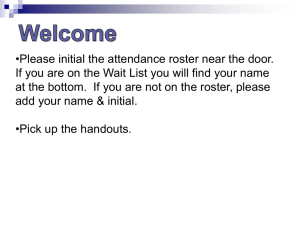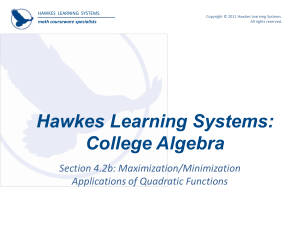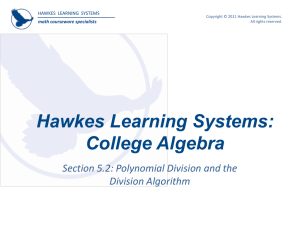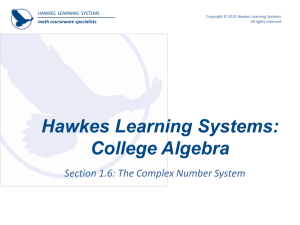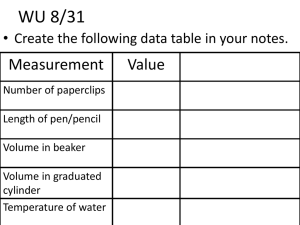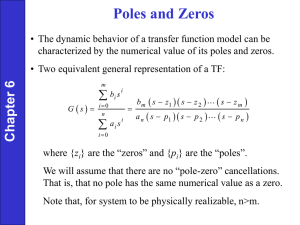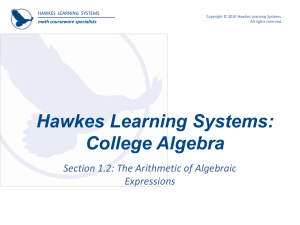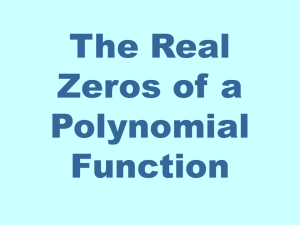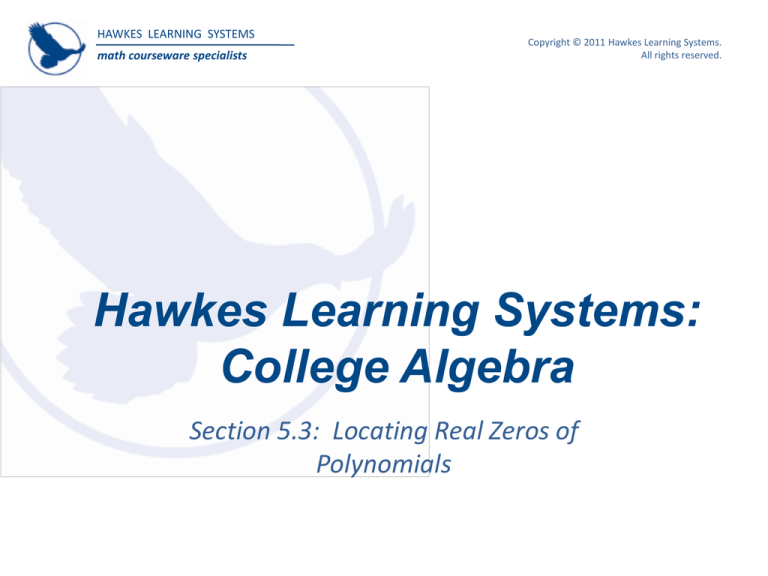
HAWKES LEARNING SYSTEMS
math courseware specialists
Copyright © 2011 Hawkes Learning Systems.
All rights reserved.
Hawkes Learning Systems:
College Algebra
Section 5.3: Locating Real Zeros of
Polynomials
HAWKES LEARNING SYSTEMS
Copyright © 2011 Hawkes Learning Systems.
All rights reserved.
math courseware specialists
Objectives
o The Rational Zero Theorem.
o Descartes’ Rule of Signs.
o Bounds of real zeros.
o The Intermediate Value Theorem.
HAWKES LEARNING SYSTEMS
math courseware specialists
Copyright © 2011 Hawkes Learning Systems.
All rights reserved.
The Rational Zero Theorem
o It can be proven (using ideas from a branch of
mathematics called abstract algebra) that there is no
formula based on elementary mathematical
operations that identifies all the zeros of an arbitrary
polynomial of degree five or higher.
o However, there are some tools that give us hints
about where to look for zeros of a given polynomial.
One such tool is the Rational Zero Theorem.
HAWKES LEARNING SYSTEMS
math courseware specialists
Copyright © 2011 Hawkes Learning Systems.
All rights reserved.
The Rational Zero Theorem
If f x a n x n a n 1 x n 1 ... a1 x a 0 is a
polynomial with integer coefficients, then any
rational zero of f must be of the form
p
q
, where
.p is a factor of the constant term a 0 and q is a
factor of the leading coefficient a n .
HAWKES LEARNING SYSTEMS
math courseware specialists
Copyright © 2011 Hawkes Learning Systems.
All rights reserved.
The Rational Zero Theorem
Caution
The Rational Zero Theorem does not necessarily find
even a single zero of a polynomial; instead it identifies
a list of rational numbers that could potentially be
zeros. In order to determine if any of the potential
zeros actually are zeros, we have to test them.
Additionally, the theorem says nothing about irrational
zeros or complex zeros. If a given polynomial has some
zeros that are either irrational or else have a non-zero
imaginary part, we must resort to other means to find
them.
HAWKES LEARNING SYSTEMS
math courseware specialists
Copyright © 2011 Hawkes Learning Systems.
All rights reserved.
Example 1: Factoring Polynomials
For the following polynomial, list all of the potential rational
zeros. Then write the polynomial in factored form and identify
the actual zeros.
3
2
f x 2 x 9 x 17 x 6
Step 1: List the factors of the
constant term, 6 , and
the leading coefficient, 2 .
Step 2: By the Rational Zero
Theorem, any rational
zero must be one of the
numbers generated by
dividing factors of a0 by
a3.
Factors of a 0 : 1, 2, 3, 6
Factors of a 3 : 1, 2
P ossible
1 3
R ational Zeros: 1, 2, 3, 6, ,
2 2
HAWKES LEARNING SYSTEMS
Copyright © 2011 Hawkes Learning Systems.
All rights reserved.
math courseware specialists
Example 1: Factoring Polynomials (Cont.)
Step 3: Use synthetic division
to identify which of the
potential zeros actually
are zeros. You may have
to try several potential
zeros before finding an
actual zero.
Step 4: Once we determine
that 1 is a zero, then we
can finish by factoring
2 x 2 11 x 6 .
1
2 9
17
6
11
11 6
6
2
2
0
f x 2 x 11 x 6 x 1
2
2 x 1 x 6 x 1
1
A ctual Zeros: , 6, 1
2
HAWKES LEARNING SYSTEMS
Copyright © 2011 Hawkes Learning Systems.
All rights reserved.
math courseware specialists
Example 2: Factoring Polynomials
For the following polynomial, list all of the potential rational
zeros. Then write the polynomial in factored form and identify
the actual zeros.
g x 4 x 37 x 2 x 93 x 54
4
3
2
Factors of a 0 : 1, 2, 3, 6, 9,18, 27, 54
Factors of a 4 : 1, 2, 4
1 3 9 27 1 3 9 27
P ossible R ational Zeros: 1, 2, 3, 6, 9,18, 27 , 54, , , ,
, , , ,
2 2 2 2 4 4 4 4
HAWKES LEARNING SYSTEMS
Copyright © 2011 Hawkes Learning Systems.
All rights reserved.
math courseware specialists
Example 2: Factoring Polynomials
g x 4 x 37 x 2 x 93 x 54
4
3
2
Use synthetic division to find the actual zeros.
3
4
37
2 93
4
2
21 54
3
30
40
28
72
8 64
72
4 32 36
0
4
54
0
3
g x 4 x 32 x 36 x 2 x
4
3
g x 4 x 9 x 1 x 2 x
4
2
3
A ctual Zeros: 9,1, 2,
4
HAWKES LEARNING SYSTEMS
math courseware specialists
Copyright © 2011 Hawkes Learning Systems.
All rights reserved.
Descartes’ Rule of Signs
Let f x a n x n a n 1 x n 1 ... a1 x a 0 be a polynomial with
real coefficients, and assume a 0 0 . A variation in sign
of f is a change in the sign of one coefficient of f to the
next, either from positive to negative or vice versa.
1. The number of positive real zeros of f is either the
number of variations in sign of f x or is less than
this by a positive even integer.
2. The number of negative real zeros of f is either the
number of variations in sign of f x or is less than
this by a positive even integer.
HAWKES LEARNING SYSTEMS
math courseware specialists
Copyright © 2011 Hawkes Learning Systems.
All rights reserved.
Descartes’ Rule of Signs
o Note that in order to apply Descartes’ Rule of Signs,
it is critical to first write the terms of the polynomial
in descending order.
o Note also that unless the number of variations in sign
is 0 or 1, the rule does not give us a definitive answer
for the number of zeros to expect.
o For example, if the number of variations in sign of
.f x is 4 , we know only that there will be 4, 2, o r 0
positive real zeros.
HAWKES LEARNING SYSTEMS
Copyright © 2011 Hawkes Learning Systems.
All rights reserved.
math courseware specialists
Example 3: Using Descartes’ Rule of Signs
Use Descartes’ Rule of Signs to determine the possible number
of positive and negative real zeros of each of the following
polynomials. Then use the Rational Zeros Theorem and other
means to find the zeros, if possible.
3
2
f x x 6 x 3 x 10
There are two variations in sign in
the function f x , so we know there
Sign
Sign
are 2 or 0 positive real zeros.
change change
f x x 6 x 3 x 10
3
2
x 6 x 3 x 10
3
2
Sign
change
There is only one variation
in sign in the function
.f x so we know there
is exactly 1 negative real
zero.
HAWKES LEARNING SYSTEMS
Copyright © 2011 Hawkes Learning Systems.
All rights reserved.
math courseware specialists
Example 3: Using Descartes’ Rule of Signs
(Cont.)
f x x 6 x 3 x 10
3
2
Factors of a 0 : 1, 2, 5,10
Factors of a n : 1
Possible R ational Zeros: 1, 2, 5,10
1
1 6
3 10
1
7 10
1 7 10
0
f x x 1 x 7 x 10
2
x 1 x 5 x 2
Zeros : 1, 5, 2
Since we know there
is exactly 1 negative
real zero, use
synthetic division to
find this first.
HAWKES LEARNING SYSTEMS
Copyright © 2011 Hawkes Learning Systems.
All rights reserved.
math courseware specialists
Example 4: Using Descartes’ Rule of Signs
Use Descartes’ Rule of Signs to determine the possible number
of positive and negative real zeros of the following polynomial.
Then use the Rational Zeros Theorem and other means to find
the zeros, if possible.
3
2
There is exactly 1
f x 2 x 6 x 10 x 30
positive real zero.
Sign
change
f x 2 x 6 x 10 x 30
3
2
f x 2 x 6 x 10 x 30
3
Sign
change
2
Sign
change
There are either 2 or 0
negative real zeros.
HAWKES LEARNING SYSTEMS
Copyright © 2011 Hawkes Learning Systems.
All rights reserved.
math courseware specialists
Example 4: Using Descartes’ Rule of Signs
(Cont.)
f x 2 x 6 x 10 x 30
3
2
Factors of a 0 : 1, 2, 3, 5, 6,10,15, 30
Factors of a n : 1, 2
1 3 5 15
P ossible R ational Zeros: 1, 2, 3, 5, 6,10,15, 30, , , ,
2 2 2 2
3
2
2
10
0
6
6
0
10
30
30
0
f x x 3 2 x 10
2
2 x 3 x
Zeros: 3, 5 , 5
5
x 5
HAWKES LEARNING SYSTEMS
math courseware specialists
Copyright © 2011 Hawkes Learning Systems.
All rights reserved.
Upper and Lower Bounds of Zeros
Assume f x is a polynomial with real coefficients, a positive
leading coefficient, and degree 1 . Let a and b be fixed numbers,
with a 0 b . Then:
1. No real zero of f is larger than b (we say b is an upper bound
of the zeros of f ) if the last row in the synthetic division of
.f x by x b contains no negative numbers. That is, b is an
upper bound of the zeros if the quotient and remainder have
no negative coefficients when f x is divided by x b .
2. No real zero of f is smaller than a (we say a is a lower bound
of the zeros of f ) if the last row in the synthetic division of
.f x by x a has entries that alternate in sign (0 can be
counted as either positive or negative, as necessary).
HAWKES LEARNING SYSTEMS
math courseware specialists
Copyright © 2011 Hawkes Learning Systems.
All rights reserved.
Example 5: Locating Bounds With Synthetic
Division
This example revisits the polynomial f x from Example 3. Use
synthetic division to identify upper and lower bounds of the real
zeros of the following polynomial.
f x x 6 x 3 x 10
3
5
2
1 6 3 10
5 5 10
1 1 2
6
0
1 6 3 10
6 0 18
1
0
3 28
We can begin by trying out any positive
number whatsoever as an upper bound.
Since there are negative numbers in the
last row, 5 is not an upper bound.
The number 6 is an upper bound
according to the theorem, as all of the
coefficients in the last row are nonnegative.
HAWKES LEARNING SYSTEMS
math courseware specialists
Copyright © 2011 Hawkes Learning Systems.
All rights reserved.
Example 5: Locating Bounds With Synthetic
Division
1
1 6 3
10
1 7 10
1
7 10
0
We find that 1 is a lower bound, as
the signs in the last row alternate.
Note: 0 can be positive or negative,
as necessary.
To summarize, we know that all real zeros of f lie in the interval
1, 6 , meaning there is no need to test the numbers 2, 5, 10,10
out of the list of potential rational zeros 1, 2, 5,10 . We have
already determined in Example 3 that the zeros of f are 1, 5, 2 ,
all of which do indeed lie in the interval 1, 6 .
HAWKES LEARNING SYSTEMS
math courseware specialists
Copyright © 2011 Hawkes Learning Systems.
All rights reserved.
Upper and Lower Bounds of Zeros
Caution
Don’t read more into the Upper and Lower
Bounds Theorem than is actually there, as
the theorem is not always powerful enough
to indicate the numbers that are the best
upper or lower bounds. The tradeoff for this
weakness in the theorem is that it is quickly
and easily applied.
HAWKES LEARNING SYSTEMS
math courseware specialists
Copyright © 2011 Hawkes Learning Systems.
All rights reserved.
The Intermediate Value Theorem
o The last technique for locating zeros that we study
makes use of a property of polynomials called
continuity.
o One consequence of continuity is that the graph of a
continuous function has no “breaks” in it.
o This means that, assuming that the function can be
graphed at all, it can be drawn without lifting the
drawing tool.
HAWKES LEARNING SYSTEMS
math courseware specialists
Copyright © 2011 Hawkes Learning Systems.
All rights reserved.
The Intermediate Value Theorem
Assume that f x is a polynomial with real
coefficients, and that a and b are real
numbers with a b . If f a and f b differ
in sign, then there is at least one point c
such that a c b and f c 0 . That is, at
least one zero of f lies between a and b .
HAWKES LEARNING SYSTEMS
math courseware specialists
Copyright © 2011 Hawkes Learning Systems.
All rights reserved.
Example 6: Approximating Zeros
Show that f x 5 x 3 x 9 has a zero between 1 and 2 .
We could determine f 1 and f 2
1 5 0 1 9
by direct computation, but for
6
5 5
many polynomials, it is quicker to
5 5 6 3
use synthetic division as illustrated.
2 5 0 1 9
Remember that the remainder
10 20 42
upon dividing f x by x k is f k ;
5 10 21 33
thus f 1 3 and f 2 33 .
The critical point is that these two
values are opposite in sign, so a
zero of f must lie between 1 and 2 .
HAWKES LEARNING SYSTEMS
math courseware specialists
Copyright © 2011 Hawkes Learning Systems.
All rights reserved.
Example 7: Approximating Zeros
Find an approximation (to the nearest tenth) of the zero between
1 and 2 for the function from Example 6, f x 5 x 3 x 9 .
Since the result of f 1.1 is
1.1 5
0
1
9
5.5 6.05 7.755
negative and the result of
f 1.2 is positive, we know
5 5.5 7.05 1.245
that the actual zero must lie
1.2 5 0 1
9
between 1.1 and 1 .2 .
5
1.15
5
5
6 7.2
9.84
6 8.2
0.84
5.75
9
6.6125 8.754375
5.75
7.6125 0.245625
0
1
The value of f midway
between 1.1 and 1 .2 is
negative, so the zero must lie
between 1.15 and 1 .2 . We
have shown that the zero, to
the nearest tenth, is 1.2.

